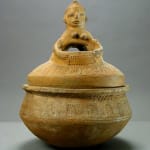Yoruba Terracotta Ceremonial Vessel, 20th Century CE
Terracotta
10 x 15.5
PF.2304 (LSO)
Further images
This appealing anthropomorphic pot was made by the Yoruba of Nigeria. It comprises a fairly plain globular base with a central waist and incised dot decoration. The lid is in...
This appealing anthropomorphic pot was made by the Yoruba of Nigeria. It comprises a fairly plain globular base with a central waist and incised dot decoration. The lid is in a slightly lighter tone of clay, similarly decorated. It is surmounted by a crouched female figure, whose limbs are a complex interplay of negative space. The coiffure is high and domed, and the cheeks and forehead are marked with the traditional triple scars of the Yoruba tribal group. The surface of the clay has not been treated with anything other than use patination.
The Yoruba are a Central Nigerian tribal group, originally descended from a Hausa migration from the northeast in about 900 AD. A small kingdom – Ile Ife – was founded by Oduduwa, followed by great sociopolitical expansion into Southwest Nigeria, Benin, and Togo. The influence of the city was felt far beyond these boundaries, however, and many smaller political entities were held under its sway. Communities were presided over by the Oba (king) and various senates (Ogboni), and councils made up of guild leaders, merchants and the lesser aristocracy (related to the Oba). The Yoruba have an exceptionally rich and diverse mythology, history and religious context, all of which are directly linked to their artistic output. In Yoruba society, this grouped heritage is known as the Itan.
While the Yoruba are renowned for their artistic production, their secular items are also valued for their clever use of raw material, conceptual innovation and elegant finish. A piece such as this may have been used as a sacrificial “altar” for offerings, or perhaps just for the careful storage of valuable objects, or even food. Whatever its purpose, it is a striking piece and a worthy addition to any collection.
The Yoruba are a Central Nigerian tribal group, originally descended from a Hausa migration from the northeast in about 900 AD. A small kingdom – Ile Ife – was founded by Oduduwa, followed by great sociopolitical expansion into Southwest Nigeria, Benin, and Togo. The influence of the city was felt far beyond these boundaries, however, and many smaller political entities were held under its sway. Communities were presided over by the Oba (king) and various senates (Ogboni), and councils made up of guild leaders, merchants and the lesser aristocracy (related to the Oba). The Yoruba have an exceptionally rich and diverse mythology, history and religious context, all of which are directly linked to their artistic output. In Yoruba society, this grouped heritage is known as the Itan.
While the Yoruba are renowned for their artistic production, their secular items are also valued for their clever use of raw material, conceptual innovation and elegant finish. A piece such as this may have been used as a sacrificial “altar” for offerings, or perhaps just for the careful storage of valuable objects, or even food. Whatever its purpose, it is a striking piece and a worthy addition to any collection.
Literature
V8
1
of
15





